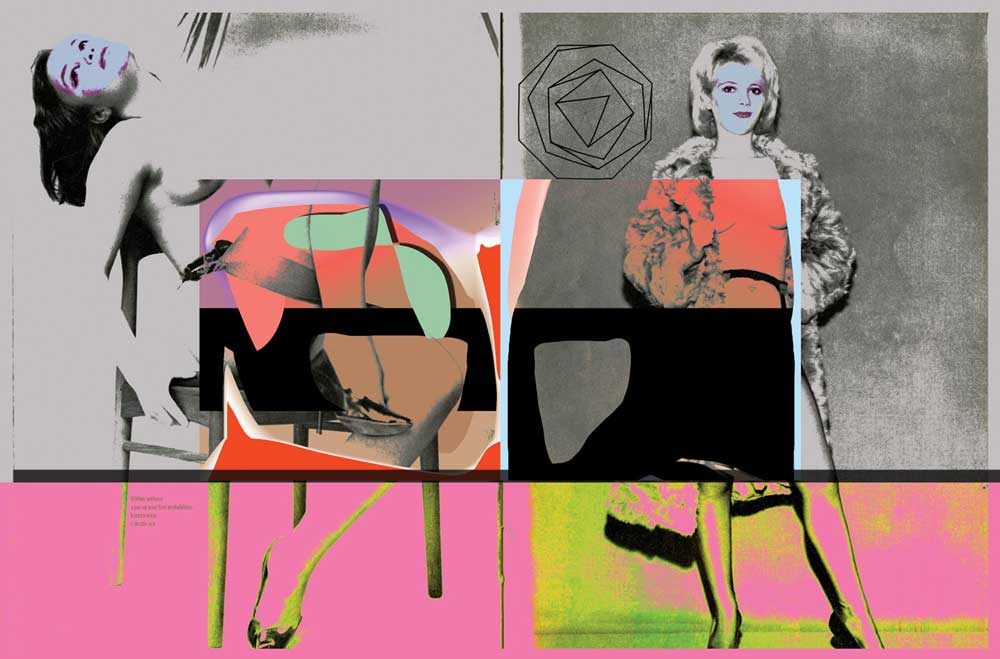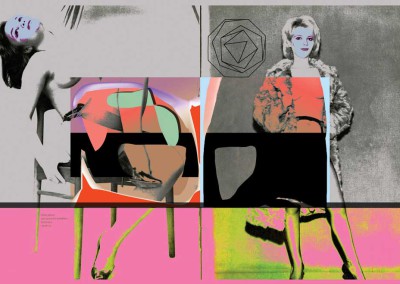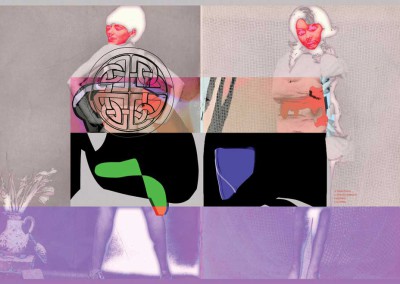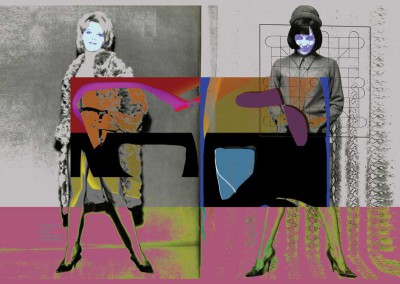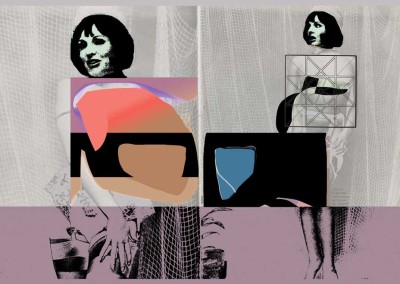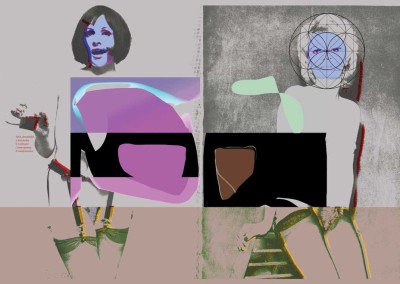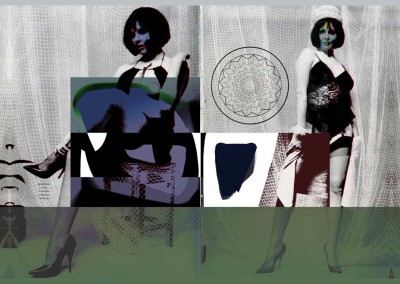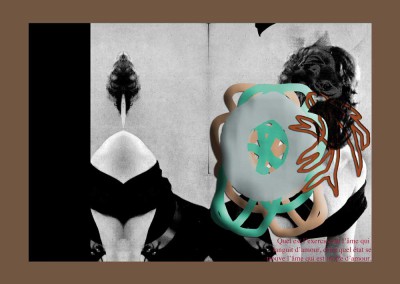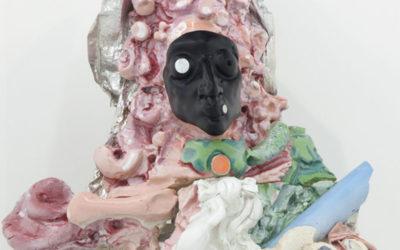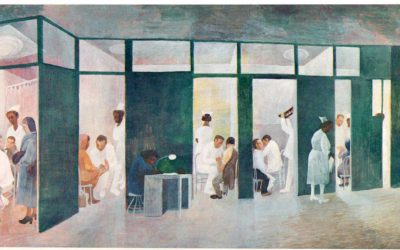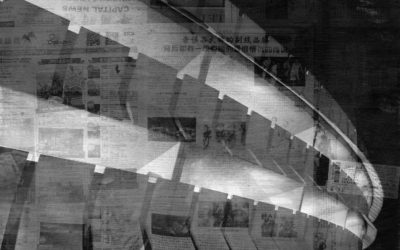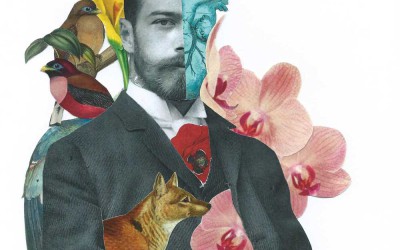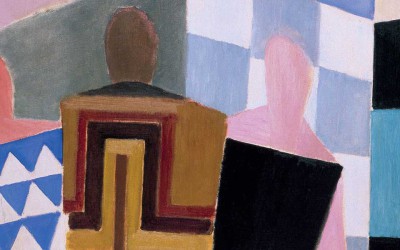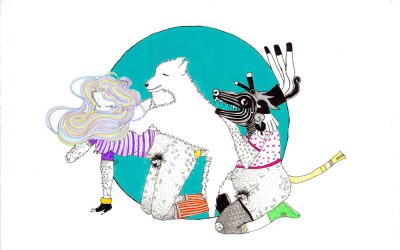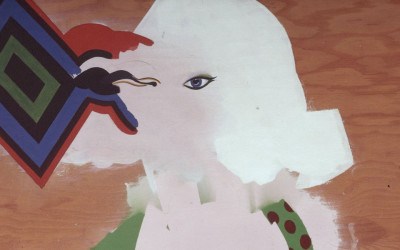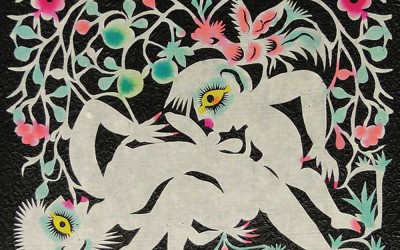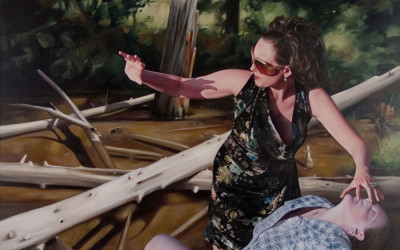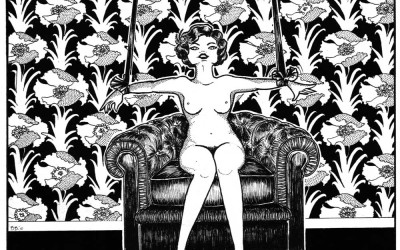AMVK
Text JF. Pierets Artwork AMVK
Anne-Mie Van Kerckhoven is known for creating a diverse body of work in painting, sculpture and installation that has made her among the most important Belgian artists of her generation. She embraces a complex array of subjects, including alchemy, mythology, artificial intelligence and mystical scriptures from the past, working with the conviction that her work can someday answer the question if we, or if we don’t possess a soul. AMVK uses existing images in a disjunctive and semi-coherent way that only make full sense in the work’s final moment, when all the layers are combined together. Her career remains a subject of fascination and understandably so, because far from the mainstream circuit, she’s busy blazing her own conceptual trail. Her relationship with creativity is raw, almost primitive in its absence of compromise or concession. We meet Anne-Mie in her beautiful atelier in Antwerp, filled with books, work in progress and nude magazines. A conversation about reincarnation, porn and the urge to draw.
Your work contains contemporary issues regarding technology and sexuality while sourcing material from the past. Why this thirst for history?
Let’s start at the beginning. More than 10 years ago I’ve bought a book called ‘La science du bien et du mal’ by Victor Géhant that was written in 1848. In this book he’s searching for the connections between the fact that we are sleeping, the fact that we divide good and evil and the fact that we are convinced of having a soul. Afterwards it seemed that this book was based on the intellectual legacy of Marguerite Porete, a French mystic who died in 1310. We’re talking about the end of the ’90s so I had to search a long time before I could find ‘Le Miroir des Âmes Simples et Anéanties’ – ‘The mirror of the simple souls’. One of the last romans chevalier and one of the first mysterienspiele. The title of Porete’s book refers to the simple soul, which is united with God and has no will, other than God’s own, a spiritual dealing with the workings of Divine Love. She was burnt at the stake for heresy in Paris in 1310 after a lengthy trial, when refusing to remove her book from circulation or recant her views. It was only until 1965, when the original Old French version of ‘Le Miroir des âmes simples’ got published, that Porete’s status became one of the greatest of Medieval Mystics, as one of the most visionary exponents of the Love Mysticism of Beguine spirituality. When I read this book I felt like dropping down, I felt that I was her reincarnation.
How did this epiphany influence your work?
It was only when I finished my Headnurse project (96 women’s bodies combined with 96 terminologies taken from books on artificial intelligence. Ref.) I realized that this mystic, Marguerite Porete, had the same issues, the same pain as I have: the agony of a huge duality between my heart and my head. In 2005 I made a trialogue between Porete, Giordano Bruno, an astronomer, and Marcuse, who wrote ‘Eros et civilisation’, because those three people are also suffering from the same pain. I made drawings inspired by this trialogue and named it ‘I’ll Rob You’. I’ve been working on the subject ever since.
Are you heading towards a point where you can bring it all together?
Yes. It’s quite an ambitious project and sometimes my head can’t stop spinning but lately there are moments in which things start to fall into place.
You once stated that every piece of work you create is a survival mechanism.
Every period in my life is outlined by a series of entities that automatically evolve into a specific theme. By using these themes in my work, I’m able to control them, able to give them a logical position in my life. You can say I translate or canalize my inner process into an exterior three-dimensional structure.
When do you stop reading and start to work?
I do everything at the same time. I have concentration issues so most of the time it turns out that I’m drawing while reading, using the lyrics in my work. I make all different kinds of work at the same time. I need my drawings to place basic things such as anger, and grief.I can’t plant that in my bigger work.
You make all sorts of work. Paintings, sculptures, installations, you name it. You were never interested in sticking to one thing?
Some people used to complain about the fact that I make too much and all too different, but that’s who I am and what I am. Let’s say I have a wild creativity. From morning till night, it never stops. Picasso was also like this and I don’t hear anyone complain about him.
Does the slightly soft porn aspect of your work cause eyebrows to be raised?
You’re referring to the fact that my work is often called obscene. I have this big amount of nude magazines dating to the sexual revolution. In those magazines I find a lot of hidden filters to work with. Starting from those pictures I’m able to explain and deal with contemporary human or social issues. My choice of images is mostly based on false feelings of indignation. They haunt me with their nasty sort of beauty. It happens that they stick to me for 10 years or more before I’m able to really deal with them. In their innocence they touch something very deep and vital. For instance look at this scene (shows a 50’s black and white image of a woman playfully hanging on a rope in an artists’ studio. Ref.), why is she hanging there like this, what was that photographer thinking? To me the whole scene hides an essential urge from both sides of the lens, even with that retouched pubic hair. I find these women and the way they are depicted extremely beautiful too. The big challenge is to combine a tantalising image with peevishness and try to end up with something new that is meaningful and interesting.
Those 50’s images are quite harmless compared to contemporary porn. Are you even more annoyed when you look at this evolution?
I hardly buy those kinds of magazines because they are too simple-minded, too focused on one thing. But new kinds of sources do inspire me. For instance a year ago I found a magazine printed in 2000 with a lot of white and red rubber and women in funny scenes, with furry donkey ears. Very inspiring, I love it. I have also this thing with plastic, from when I was a kid. Lately I worked a lot with Sleek magazine with its homoerotic- and sado-masochistic images, flirting again with nazi-imagery, dark heavy leather, and bearded sexy men with an Arabic touch, in skirts. And again, quasi-silly. I find this all interesting and double because these magazines pretend merely to exist to sell clothes.
It sounds like you have the fierce need to push the limits of your inspiration?
Connecting sex and technology has always been my main activity as an artist . I am intrigued why naked women are portrayed, but on the other hand I’m also truly inspired by all things regarding the synthetic; thermodynamical laws and outer space issues. I had that since I was a child. I work with computers since 1977. I’m a pioneer when it comes to that. When I studied at the art academy we had a lot of contact with students who were both aspirant scientists as well as musicians. Performers. By that time I got very well acquainted with Luc Steels, who later started the laboratory of artificial intelligence (AI) at the VUB in Brussels, and it is thanks to him that I could start working with computers so early. I made my first movie on a very rigid piece of machinery that could only go black and white and was hugely pixelated.
‘Connecting sex and technology has always been my main activity as an artist. I am intrigued why naked women are portrayed, but on the other hand I’m also truly inspired by all things regarding the synthetic; thermodynamical laws and outer space issues.’
What interested me from the start is that you can keep on working in different layers, which you can manipulate apart from each other, without focusing on a final result. And of course I loved drawing my naked women on these highly sophisticated machines. Something quite unusual to be done in the sterility of an AI-lab. The symbolic gesture of it was a statement and of big importance to me at the time.
What’s so interesting about artificial intelligence?
I always had this hunger for consuming science, as an outsider. I had a subscription on ‘The New Scientist’ as a student. In the beginning of the 80’s AI kept on searching for the essence of what defines human beings. Things like: what is intelligence, what is creativity, and how they related to each other. The books on knowledge representation reflected a modern kind of theology to me. AI used psychology and philosophy research and terminology, in order to develop new insights and to compact the abstract. At a certain moment the trail somewhat fell apart on the idea that language was the thing that made us more intelligent than other species. Later they decided that it is the complexity of human social structures that made us develop technologies as we do. As an artist I quickly knew I was more mesmerized by all things evolutionary, new ideas and new perceptions instead of art itself. Include my distrust towards the art world, because there were so few female examples, hardly any women to be found in art history books, and I soon felt much more liberated being creative in an atmosphere of science, logic and future.
How long did it take to find your path?
Not very long. As soon as I left the academy I started reading De Sade and Wittgenstein. This, combined with The New Scientist magazine, really influenced my choices.
Is there something you are looking for?
I’m not necessarily looking for something but I’m trying to make connections. I’m very conscious about all those different significance layers in reality and I like creating things that places everything back in perspective. That doesn’t exist in real life but it does in my work. Maybe it’s because I read a lot of fairy tales when I was young.
You talked earlier about the lack of women in the art world. Do you feel in place?
I consider myself a stand-alone. The past 10 years I thought a lot about it, but recently I decided to stop doing that. It starts to get too upsetting. The art world is mostly ruled by men. You have to have that certain mentality that when you find something that works, you stick to it. You are constantly supposed to stimulate the surroundings by shouting: look at me, look at my work, I’m the only thing that matters. You have to have an obese ego and I loathe it. I don’t know how this works with the younger generation of female artists. Maybe it has to do with the way I am brought up as a woman, that I keep other people as much in account as I do myself. For me the way I do it though is the only way I want it.
Do you find it important what people think about your work?
I’m very much interested in what people think about my work but I don’t take their judgments into account. When you work on something in your studio, you have a very intimate contact with your creation. You are in fact your work. From the moment you share it with another person you start looking through his or her eyes and your work has already changed by then. So it’s very important with whom I’m watching. After a while you let go, but in the beginning it’s essential.
And the final question; do you like living in Antwerp?
I do, I have a wonderful atelier here and Antwerp has a good vibe. I guess that’s why there are so many great artists living here. The only thing that bothers me is the lack of good spots to party, to dance. Since I’m also a DJ, maybe I’ll have to start one myself. Anyone interested?
Related articles
Nadia Naveau
From the moment I started at the academy I noticed that sculpting was very demanding on both a physical and a psychological level. This has never diminished. I very much like what I do, but a large percentage of my practice involves…..
Bernard Perlin
In One-Man Show, Michael Schreiber chronicles the storied life, illustrious friends and lovers, and astounding adventures of Bernard Perlin through no-holds-barred interviews with the artist, candid excerpts from Perlin’s unpublished…..
Faryda Moumouh
Since I was young I was already drawing, watching, registering details from the things I saw. It was an urge and I had the feeling I was chosen by a visual language, which I pursued. I went to art school when I was 14 and it made me discover…..
Agustin Martinez
“Dancers don’t always know what they are doing”, “Revelations from a sailor from Rotterdam” and “The past is alert and ready” are just a few of the many intriguing titles of the work by collagist Agustin Martinez; a fellow countryman of Pablo Picasso…..
George Quaintance
George Quaintance was an artist ahead of his time, a man who forged several successful careers, yet never enjoyed mainstream fame. Had he been born a few decades later, we might know him today as a multi-tasking celebrity stylist, as a coach…..
Sonia Delaunay
Sonia Delaunay (1885–1979) was a key figure in the Parisian avant-garde, whose vivid and colorful work spanned painting, fashion and design. Tate Modern presents the first UK retrospective to assess the breadth of her vibrant artistic…..
Rurru Mipanochia
Rurru Mipanochia is a 25 year old, Mexican illustrator. Her drawings represent ancient pre-Hispanic sexual deities, transvestites and transseksuals, in order to promote dissident sexualities and to create a visual questioning about beauty…..
Allen Jones
Three women, wearing black leather fetish gear, produced by the same company that supplied Diana Rigg’s costumes in The Avengers. One of them is on all fours and the glass top on her back awaits your drink. The second one wears thigh high…..
Xiyadie
Paper-cuts originated in Eastern Han Dynasty China (AD 25-220) and are hung on windows or doors for good luck. But instead of the usual decorative flowers and birds, Xiyadie, whose pseudonym means ‘Siberian Butterfly’, portrays graphic and…..
Jennifer Nehrbass
Someone once wrote that she was dismantling the roles and stereotypes of beauty and femininity, examining the psychology that leads women to go to extremes to maintain beauty and style. Needless to say that our brain got tickled so we…..
Betty Black
Betty Black started off as a name, just a made up name. An alter-ego that I created for myself in an attempt to perfect one distinctive style of work, rather than end up with a variety of mediocre crap, after having just coasted through a pointless…..
